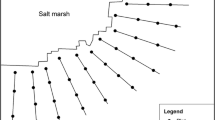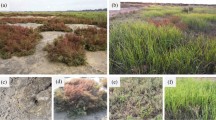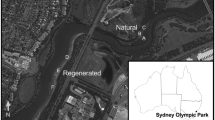Abstract
Purpose
Soil degradation through salinization and alkalinization is one of the most widespread abiotic stresses threatening the health and functions of wetlands in the world. However, the relationship of this degradation to vegetation change in salt-affected inland wetlands is not well understood.
Methods
We studied the structure, density, and richness of aboveground vegetation, and soil physicochemical properties in Carex and Phragmites-dominated wetlands along a soil saline-alkalinization gradient in the Songnen Plain, China. We also compared the seed bank responses of Carex- and Phragmites-dominated communities to saline-alkaline stress in a greenhouse study.
Results
Following a structural equation model (SEM), the soil salinity and alkalinity were related to a decrease in the density and richness of aboveground vegetation. These environments indirectly affected the aboveground vegetation by reducing soil nutrients as well as the species richness and seed density of soil seed banks. Greenhouse experiments found that soil seed banks of Carex communities were more sensitive to saline-alkaline stress than Phragmites communities, especially the sedge species. SEM linked pathways of soil degradation, seed bank change, and plant diversity decline.
Conclusions
Our study indicates that soil salinity and alkalinity, as a critical environmental filter, could drive the decline of native freshwater species, especially for certain keystone sedge species, in salt-affected wetlands. Limiting agricultural development and restoring flood pulses across landscapes is necessary to alleviate soil salinization, deliver seeds and maintain the region’s freshwater vegetation in salt-affected inland wetlands.





Similar content being viewed by others
Data availability
Not applicable.
References
Ardón M, Morse JL, Colman BP, Bernhardt ES (2013) Drought-induced saltwater incursion leads to increased wetland nitrogen export. Global Change Biol 19:2976−2985. https://doi.org/10.1111/gcb.12287
Chen YN, Wang Q, Li WH, Ruan X (2007) Microbiotic crusts and their interrelations with environmental factors in the Gurbantonggut desert, western China. Environ Geol 52:691–700. https://doi.org/10.1007/s00254-006-0505-9
Cheng XW, Zhu H, Banuelos B, Yan BX, Shutes B, Liang Y, Chen X (2018) Saline-alkaline tolerance of hygrophilous plant species during their asexual propagation and continued growth stages. S Afr J Bot 118:129–137. https://doi.org/10.1016/j.sajb.2018.07.005
Fox J, Weisberg S (2019) An R Companion to Applied Regression, 3rd edn. Sage, Thousand Oaks
Fu PY (1995) Clavis Plantatrum Chinae Boreali-Orientalis. Science Press, Beijing (in Chinese)
Grace JB (2015) Structural Equation Modeling and Natural Systems. Cambridge University Press, Cambridge
Herbert ER, Boon P, Burgin AJ, Neubauer SC, Franklin RB, Ardón M, Hopfensperger KN, Lamers LPM, Gell P (2015) A global perspective on wetland salinization: ecological consequences of a growing threat to freshwater wetlands. Ecosphere 6:206. https://doi.org/10.1890/ES14-00534.1
Jolly ID, Mcewan KL, Holland KL (2008) A review of groundwater-surface water interactions in arid/semi-arid wetlands and the consequences of salinity for wetland ecology. Ecohydrol 1:43–48. https://doi.org/10.1002/eco.6
Laliberté E, Zemunik G, Turner BL (2014) Environmental filtering explains variation in plant diversity along resource gradients. Science 345:1602. https://doi.org/10.1126/science.1256330
Li XX, Yang W, Li SZ, Sun T, Bai JH, Pei J, Xie T, Cui BS (2020) Asymmetric responses of spatial variation of different communities to a salinity gradient in coastal wetlands. Mar Environ Res 158:105008. https://doi.org/10.1016/j.marenvres.2020.105008
Liu XT (2001) Management on Degraded Land and Agricultural Development in the Songnen Plain (in Chinese). Science Press, Beijing
Liu Y, Ding Z, Bachofen C, Lou YJ, Jiang M, Tang XG, Lu XG, Buchmann N (2018) The effect of saline-alkaline and water stresses on water use efficiency and standing biomass of Phragmites australis and Bolboschoenus planiculmis Sci Total Environ 644:207–216. https://doi.org/10.1016/j.scitotenv.2018.05.321
Lu RK (2000) Soil Agricultural Chemical Analysis Method. China Agricultural Science and Technology Press, Beijing (in Chinese)
Ma MJ, Baskin CC, Yu KL, Ma Z, Du GZ (2017) Wetland drying indirectly influences plant community and seed bank diversity through soil pH. Ecol Indic 80:186–195. https://doi.org/10.1016/j.ecolind.2017.05.027
Middleton BA (1999) Wetland restoration, flood pulsing and disturbance dynamics. Wiley, New York
Middleton BA (2016) Effects of salinity and flooding on post-hurricane regeneration potential in coastal wetland vegetation. Am J Bot 103:1–16. https://doi.org/10.3732/ajb.1600062
Middleton BA, Souter NJ (2016) Functional integrity of freshwater forested wetlands, hydrologic alteration, and climate change. Ecosyst Health Sust 2:e01200. https://doi.org/10.1002/ehs2.1200
Nilsson C, Brown RL, Jansson R, Merritt DM (2010) The role of hydrochory in structuring riparian and wetland vegetation. Biol Rev 85:837–858. https://doi.org/10.1111/j.1469-185X.2010.00129.x
Noe G, Krauss K, Lockaby BG, Conner W, Hupp C (2013) The effect of increasing salinity and forest mortality on soil nitrogen and phosphorus mineralization in tidal freshwater forested wetlands. Biogeochemistry 114:225–244. https://doi.org/10.1007/s10533-012-9805-1
Parida AK, Das AB (2005) Salt tolerance and salinity effects on plant: a review. Ecotox Environ Safe 60:324–349. https://doi.org/10.1016/j.ecoenv.2004.06.010
R Core Team (2021) R: a language and environment for statistical computing and graphics. http://www.R-project.org/. Accessed 5 Jan 2022
Richardson CJ (1985) Mechanisms controlling phosphorus retention capacity in freshwater wetlands. Science 228:1424–1426. https://doi.org/10.1126/science.228.4706.1424
Rietz DM, Haynes RJ (2003) Effects of irrigation-induced salinity and sodicity on soil microbial activity. Soil Biol Biochem 35:845–854. https://doi.org/10.1016/S0038-0717(03)00125-1
Robertson HA, James KR (2007) Plant establishment from the seed bank of a degraded floodplain wetland: a comparison of two alternative management scenarios. Plant Ecol 188:145–164. https://doi.org/10.1007/s11258-006-9153-0
Rohal CB, Adams AR, Reynolds LK, Hazelton ELG, Kettenring KM (2021) Do common assumptions about the wetland seed bank following invasive plant removal hold true? Divergent outcomes following multi-year Phragmites australis management. Appl Veg Sci 24:e12626. https://doi.org/10.1111/avsc.12626
Rosseel Y (2012) lavaan: an R package for structural equation modeling. J Stat Softw 48:1–36. https://doi.org/10.18637/jss.v048.i02
Sahab S, Suhani I, Srivastava V, Chauhan PS, Singh RP, Prasad V (2021) Potential risk assessment of soil salinity to agroecosystem sustainability: Current status and management strategies. Sci Total Environ 764:144164. https://doi.org/10.1016/j.scitotenv.2020.144164
Shumway SW, Bertness MD (1992) Salt stress limitation of seedling recruitment in a salt marsh plant community. Oecologia 92:490–497. https://doi.org/10.1007/BF00317840
Wang CH, Lu M, Yang B, Yang Q, Zhang XD, Hara T, Li B (2010) Effects of environmental gradients on the performances of four dominant plants in a Chinese saltmarsh: implications for plant zonation. Ecol Res 25:347–358. https://doi.org/10.1007/s11284-009-0662-x
Wang M, Liu XT, Zhang JT, Li XJ, Wang GD, Li XY, Chen WW (2015) Soil respiration associated with plant succession at the meadow steppes in Songnen Plain, Northeast China. J Plant Ecol 8:51–60. https://doi.org/10.1093/jpe/rtu006
Wang XY, Cheng R, Zhu H, Cheng X, Shutes B, Yan B (2020) Seed germination and early seedling growth of six wetland plant species in saline-alkaline environment. Intern J Phytoremediat 22:1185–1194. https://doi.org/10.1080/15226514.2020.1748565
Wei TY, Simko V(2021) R package ‘corrplot’: visualization of a correlation matrix. R package version 0.92
Wetzel PR, Kitchens WM, Brush JM, Dusek ML (2004) Use a reciprocal transplant study to measure the rate of plant community change in a tidal marsh along a salinity gradient. Wetlands 24:879–890. https://doi.org/10.1672/0277-5212(2004)024[0879:UOARTS]2.0.CO;2
Xi HY, Feng Q, Zhang L, Si JH, Chang ZQ, Yu TF, Guo R (2016) Effects of water and salinity on plant species composition and community succession in Ejina Desert Oasis, northwest China. Environ Earth Sci 75:138. https://doi.org/10.1007/s12665-015-4823-7
Xu H, Huang XJ, Zhong TY, Chen ZG, Yu J (2014) Chinese land policies and farmers’ adoption of organic fertilizer for saline soils. Land Use Pol 38:541–549. https://doi.org/10.1016/j.landusepol.2013.12.018
Yi FK, Yi XY, Lou YJ, Wang X (2008) Wetland Wild Vascular Plants in Northeastern China. Science Press, Beijing (in Chinese)
Yu H, Liu MY, Du BJ, Wang ZM, Hu LJ, Zhang B (2018) Mapping soil salinity/sodicity by using Landsat OLI imagery and PLSR algorithm over semiarid west Jilin province, China. Sensors 18:1048. https://doi.org/10.3390/s18041048
Yuckin S, Rooney R (2019) Significant increase in nutrient stocks following Phragmites australis invasion of freshwater meadow marsh but not of cattail marsh. Front Env Sci 7:112. https://doi.org/10.3389/fenvs.2019.00112
Zhang DJ, Qi Q, Wang XH, Tong SZ, An Y (2019) Eco-physiological responses of Carex schmidtii to soil salinization in a Chinese wetland. Pol J Environ Stud 28:4009–4015. https://doi.org/10.15244/pjoes/94990
Zhao CZ, Zhang H, Song CP, Zhu JK, Shabala S (2020) Mechanisms of plant responses and adaptation to soil salinity. The Innov 1:100017. https://doi.org/10.1016/j.xinn.2020.100017
Zhao YT, Wang GD, Zhao ML, Wang M, Jiang M (2022) Direct and indirect effects of soil salinization on soil seed banks in salinizing wetlands in the Songnen Plain, China. Sci Total Environ 819:152035. https://doi.org/10.1016/j.scitotenv.2021.152035
Acknowledgements
We thank Dr. Beth Middleton for suggestions and English editing.
Funding
This study was supported by the National Natural Science Foundation of China (41877075, 42077070, 41871081, U19A2042, 41771108), the Natural Science Foundation of Jilin Province (20200201213JC), and the Youth Innovation Promotion Association CAS (2019234).
Author information
Authors and Affiliations
Contributions
Y.Z. and G.W. designed the study; Y.Z., G.W., M.Z., M.W., B.L., and M.J. performed the experiments; Y.Z. analyzed the data; Y.Z. and G.W. drafted the manuscript.
Corresponding author
Ethics declarations
Competing interests
The authors have no relevant financial or non-financial interests to disclose.
Additional information
Responsible Editor: Gustavo Gabriel Striker.
Publisher’s note
Springer Nature remains neutral with regard to jurisdictional claims in published maps and institutional affiliations.
Supplementary Information
Below is the link to the electronic supplementary material.
ESM 1
(DOCX 23.7 KB)
Rights and permissions
About this article
Cite this article
Zhao, Y., Wang, G., Zhao, M. et al. How soil salinization and alkalinization drive vegetation change in salt-affected inland wetlands. Plant Soil 480, 571–581 (2022). https://doi.org/10.1007/s11104-022-05600-4
Received:
Accepted:
Published:
Issue Date:
DOI: https://doi.org/10.1007/s11104-022-05600-4




